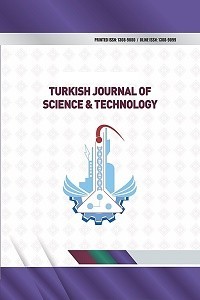Investigation of the Properties of Warm Mix Asphalt Involving Organic Additive
Investigation of the Properties of Warm Mix Asphalt Involving Organic Additive
Warm mix asphalt, Organic additive, Mixture characteristics, Dynamic shear rheometer, Fatigue behaviour, Hamburg wheel tracking device,
___
- 1. Newcomb, D. (2006). An introduction to warm-mix asphalt. National Asphalt Pavement Association. 2. Hurley, G. C., Prowell, B. D. (2006). Evaluation of potential process for use in warm mix asphalt. J Assoc Asphalt Paving Technol., vol. 75, pp. 41-90. 3. Kristjansdottr, O., Muench, S. T., Michael, L., Burke, G. (2007). Assessing potential for warmmix asphalt technology adoption. Transport Res Rec., vol. 2040, pp. 91-99. 4. Rubio, M. C., Martinez, G., Baena, L., Moreno, F. (2012). Warm mix asphalt: an overview. J Cleaner Prod., vol. 24, pp. 76-84. 5. D’Angelo, J., Harm, E., Bartoszek, J., Baumgardner, G., Corrigan, M., Cowsert, J., et al. (2008). Warm-mix asphalt European practice. American Trade Initiatives. 6. Croteau, J. M., Tessier, B. (2008). Warm mix asphalt paving technologies: a road builder’s perspective. The 2008 Annual Conference of the Transportation Association of Canada. 7. Button, J. W., Estakhri, C., Wimsatt, A. (2007). A synthesis of warm-mix Asphalt. Texas Transportation Institute, The Texas A&M University. 8. Hurley, G. C., Prowell, B. D. (2005). Evaluation of Sasobit for use in warm mix asphalt. National Center for Asphalt Technology. 9. Jamshidi, A., Hamzah, M. O., You, Z. (2013). Performance of Warm Mix Asphalt containing Sasobit®: State-of-the-art. Construction and Building Materials, vol. 38, pp. 530-553. 10. Zaumanis, M. (2010). Warm mix asphalt investigation. M.Sc. Thesis, Technical University of Denmark, Kgs.Lyngby. 11. D’Angelo, J., Harm, E., Bartoszek, J., Baumgardner, G., Corrigan, M., Cowsert, J., Harman, T., Jamshidi, M., Jones, W., Newcomb, D., Prowell, B., Sines, R., Yeaton, B. (2008). Warm-mix asphalt: European practice. American Trade Initiatives. 12. Austerman, A. J., Mogawer, W. S., Bonaquist, R. (2009). Evaluating the effects of warm mix asphalt technology additive dosages on the workability and durability of asphalt mixtures containing recycled asphalt pavement. Transportation Research Board 88th Annual Meeting. 13. Kanitpong, K., Nam, K., Martono, W., Bahia, H. (2008). Evaluation of a warm mix asphalt additive. Construction Materials. vol. 161(1), pp. 1-8. 14. O’Sullivan, K., Wall, P. (2009). The effect of warm mix asphalt additives on recycled asphalt pavement. Worcester Polytechnic Institute. 15. American Society for Testing and Materials (2006). ASTM D5-06: Standard test method for penetration of bituminous materials. West Conshohocken, PA. 16. American Society for Testing and Materials (2000). ASTM D36-95: Test method for softening point of bitumen (ring and ball apparatus). West Conshohocken, PA. 17. American Society for Testing and Materials (2002). ASTM D 1754-97: Standard test method for effects of heat and air on asphaltic materials (thin-film oven test).; West Conshohocken, PA. 18. Read, J., Whiteoak, D. (2003). The Shell bitumen handbook. Thomas Telford Publishing, London. 19. Specht, L. P., Khatchatourian, O., Brito, L. A. T., Ceratti, J. A. P. (2007). Modelling of asphalt-rubber rotational viscosity by statistical analysis and neural networks. Materials Research. vol. 10(1), pp. 69-74. 20. American Society for Testing and Materials (2002). ASTM D4402-06: Standard test method for viscosity determination of asphalt at elevated temperatures using a rotational viscometer. West Conshohocken, PA. 21. American Society for Testing and Materials (2011). ASTM D3549-11: Standard test method for thickness or height of compacted bituminous paving mixture specimens. West Conshohocken, PA. 22. American Society for Testing and Materials (2012). ASTM D6931-12: Standard test method for indirect tensile (IDT) strength of bituminous mixtures. West Conshohocken, PA. 23. British Standards Institution (1993). BS DD 213: Method for determination of the indirect tensile stiffness modulus of bituminous mixtures. Draft for development, London. 24. British Standards Institution (1997). BS DD ABF: Method for determination of the fatigue characteristics of bituminous mixtures using indirect tensile fatigue. Draft for development, London. 25. Nejad, F. M., Aflaki, E., Mohammadi, M. A. (2010). Fatigue behavior of SMA and HMA mixtures. Constr Build Mater., vol. 24, pp. 1158-1165. 26. Nejad F. M., Azarhoosh, A., Hamedi, G.H., Roshani, H. (2014). Rutting performance prediction of warm mix asphalt containing reclaimed asphalt pavements. Road Materials and Pavement Design, vol. 15(1), pp. 207-219. 27. European Committee for Standardization (2003). EN 12697-22. Bituminous mixtures - Test methods for hot mix asphalt - Part 22: Wheel tracking. 28. Sengoz, B., Isikyakar, G. (2008). Analysis of styrene-butadiene-styrene polymer modified bitumen using fluorescent microscopy and conventional test methods. Journal of Hazardous Materials, vol. 150, pp. 424-432.
- ISSN: 1308-9080
- Başlangıç: 2009
- Yayıncı: Fırat Üniversitesi
Investigation of Soft Stories in Buildings with Hollow Block Slab
Ozan Ince, Humeyra Sahin, Kursat Esat Alyamac, Zulfu Cinar Ulucan
Investigation of Live-Bed Scour at Labyrinth Side Weirs
Mustafa Tunç, M. Emin Emiroğlu
Mustafa Ülker, Ercan Işık, Mehmet Ülker
Deformation Measurements and Analysis with Robust Methods: A Case Study, Deriner Dam
Berkant KONAKOĞLU, Ertan GÖKALP
Taner ALATAŞ, Mehmet YİLMAZ, Baha Vural KÖK
CFD Analysis of Ilısu Dam Sluice Outlet
M. Cihan AYDİN, Ali Emre ULU, Çimen KARADUMAN
Özge ERDOĞAN YAMAÇ, Mehmet YILMAZ, Baha Vural KÖK
Multy Variable Grey Method For Multy Point Deformation Analysis
Assessment of Earthquake Behavior of Reinforced Concrete Buildings with Slab Discontinuity
